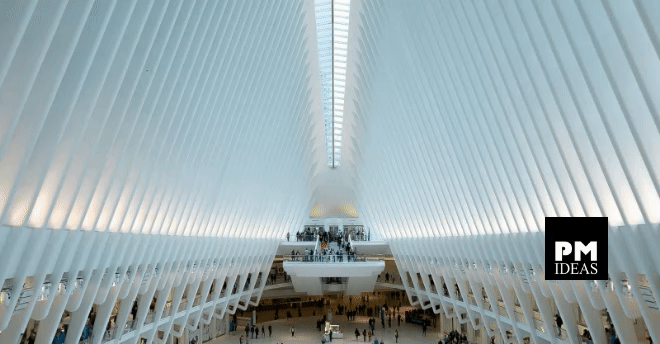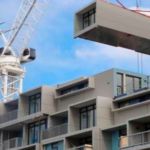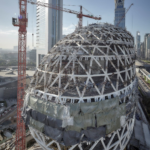Puedes leer el artículo en español: «¿Qué nos depara la gestión de proyectos en construcción en 2024?», publicado en Stakeholders.news
What Does Construction Project Management Hold for Us in 2024?
As if we were at a train station on the brink of a new journey, we ask ourselves: «Where will 2024 take us in the direction of construction project management?»
This year promises to be a fascinating journey filled with innovations and challenges that will reshape our industry. Below, we explore the most impactful trends that will mark our route on this exciting journey.
Sustainability Construction: The First Carriage of Our Train
Sustainability has become the leading carriage of our train towards the future. Construction must comply with environmental regulations and integrate sustainable practices at its core. Low carbon emission materials and sustainable construction practices respond to global demands and provide an opportunity to innovate and lead in an increasingly environmentally conscious market.
As Deloitte discusses in its article 2024 Engineering and Construction Industry Outlook, as we move towards 2024, sustainability remains a critical imperative for the construction industry. Architecture, Engineering, and Construction (AEC) firms are balancing the need for sustainable building practices with the challenges of evolving market trends, environmental regulations, and rising construction costs.
Buildings are significant contributors to global energy consumption and emissions. The industry is aligning with global initiatives like the International Energy Agency’s Net Zero Emissions by 2050 Scenario, which targets zero-carbon readiness for all new buildings and a significant portion of existing structures by 2030. AEC firms prioritize sustainability, integrate it into their business strategies, and adopt practices that reduce embodied carbon in materials, utilize energy-efficient equipment, and implement passive design principles.
Cost-effectiveness remains a key consideration, with the industry recognizing that long-term lifecycle savings can offset the initial costs of sustainable construction. This includes investments in high-performance facades and energy.
Construction firms are also exploring passive design techniques to enhance building efficiencies and experimenting with advanced materials like self-healing concrete and high-performance, eco-friendly components. This push towards sustainability is not only a market differentiator but also aligns with evolving customer priorities and a response to increasing severe weather events.
Early integration of sustainable design tactics in the conceptual phase and adopting circular economy principles are becoming more prevalent. Technologies like generative design, simulations, and Building Information Modeling (BIM) enable AEC firms to effectively model building performance and carbon footprint, streamlining project delivery and reducing emissions.
Digital Technology and Emotional Intelligence: Travel Companions
Technology, especially BIM, has transformed our way of working for years. The European Directive on Energy Efficiency in Buildings (EPBD) is a clear example of how regulations drive greater adoption of technologies like BIM to promote more efficient and sustainable buildings. On this journey, where we encounter increasingly complex projects and diverse teams, empathy, effective communication, and emotional understanding are crucial skills for any project leader. BIM facilitates more effective planning and allows for more precise and collaborative project management.
This digital advancement has an essential companion: emotional intelligence to communicate and lead an increasingly complex social environment around projects. Technology provides us with tools, but emotional intelligence allows us to guide our teams to success.
Robotics and Automation: New Passengers on Our Train
Robotics and automation join our journey, redefining roles and improving efficiency on the construction site. For example, ABB has presented at REBUILD 2023 robotic solutions for modular construction and manufacturing construction elements. In addition, robotic and automated systems such as autonomous vehicles and drones are improving efficiency and safety in construction projects.
ABB’s robots are revolutionizing the construction industry by improving the efficiency of processes and work quality and ensuring worker safety. They are employed in various tasks, from 3D printing complex building structures to assembling and fabricating construction elements. This includes cutting and welding metal structures, handling parts, applying adhesives and sealants, and tasks like painting and polishing.
In addition to robotics, ABB also presented its electrification solutions for smart, sustainable buildings. The event showcased ABB’s advanced home automation technology. By adopting these technologies, ABB is enhancing the manufacturing of essential building materials and components and the daily energy efficiency of buildings. This convergence of robotics, automation, and smart technologies sets a new standard in the construction industry, perfectly aligning with our journey toward 2024.
3D Printing: Shaping the Future of Construction Project Management
As we move towards 2024, 3D printing in construction transcends beyond crafting miniature models; it’s emerging as a critical factor in building processes. This technology empowers the creation of lightweight construction elements like steel nodes and cement molds. 3D printing is also an eco-friendly innovation, fostering the development of materials that contribute to a building’s energy efficiency. This advancement empowers architects and engineers to transcend traditional design limitations, enabling complex and previously unattainable architectural designs.
As 2024 approaches, 3D printing is poised to revolutionize the construction sector, reducing costs, accelerating construction timelines, and unlocking new design potential, thus becoming a pivotal aspect of construction project management.
Augmented and Virtual Reality: Windows to New Worlds
AR and VR offer us windows to virtual worlds that transform how we visualize and interact with our projects. These technologies improve client and team communication, allowing for more effective planning and problem-solving.
Hybrid Project Management Models: Changing Tracks
This shift towards mixed projects that increasingly depend on technology and AI-based models requires more hybrid life-cycle approaches. Adopting hybrid project management models reflects a shift in tracks towards greater adaptability. The combination of Waterfall and Agile methodologies allows us to better respond to the changing needs of our projects and teams, setting a new pace in our way of leading.
As Lalmi, Fernandes, and Boudemagh analyze the possibilities of A Hybrid Project Management Model for Construction Projects in their article, concluding that this model addresses the increasing complexity of such construction projects. The research underscores the potential of the Hybrid model in reducing project duration and costs, enhancing client interaction, and minimizing waste.
Artificial Intelligence: The Locomotive of the Future
Finally, if the previous trends won’t be strictly new in 2024, our terminal station, Artificial Intelligence, will be a novelty due to its extensive use. AI represents a significant change in how we manage projects. In this new year, AI becomes the locomotive that propels us towards more efficient, innovative, and proactive project management.
Generative AI, which involves machines creating new content across various formats, is at the forefront of this innovation. Construction technology companies are actively exploring the potential of generative AI to enhance efficiencies and adapt it to their business needs. This focus on technology is driven by the need to mitigate ongoing challenges in the workforce, costs, and supply chain.
However, adopting AI in the industry faces barriers, such as identifying the right use cases and concerns around cyber risk and data security. Despite these challenges, the potential applications of generative AI are diverse, offering benefits like cost reduction, improved building performance, safety, and sustainability.
As the industry experiments with these technologies, there is a recognition of the need for human intelligence and oversight in a ‘human-in-the-loop’ concept.
AEC firms are also exploring the practical applications of various AI and emerging technologies, including drones, autonomous vehicles, robotics, BIM, and IoT sensors. These technologies can significantly improve profit margins, foster stronger partnerships, and improve integrated project delivery through transparent data-sharing.
As the industry experiments with these technologies, the need for human intelligence and oversight is recognized in a ‘human-in-the-loop’ concept. This approach involves skilled individuals for tasks like fact-checking and in-depth analysis. For these technological initiatives to be widely adopted and scalable, strong ecosystem alliances and partnerships encompassing technology providers, operations vendors, contractors, and automation vendors are crucial. The journey toward 2024 in the construction industry is thus marked by a blend of advanced AI technologies and human expertise, shaping a more efficient, productive, and sustainable future.
Architecture and Construction 2024: Ready for the Journey
Next year, we embark on a journey that promises to transform the construction sector.
As we approach 2024, the construction industry is on the cusp of a transformative era driven by technological innovation. CONSTRUCTION COMPANIES are set to navigate this new landscape by integrating advanced technologies like BIM, AR, VR, and digital printing, enhancing efficiency and project outcomes. Embracing sustainability and smart technology will be crucial, moving from optional practices to essential environmental and economic benefits strategies. This forward-thinking approach, coupled with a focus on workforce development and upskilling, will help businesses navigate the evolving industry and position them as leaders in the field. As the industry moves into this new era, adaptability, innovation, and a commitment to sustainability will define the success of businesses in the architecture and construction sector.
As PROJECT MANAGERS, our challenge and opportunity is to lead this journey with adaptability and vision. Our ability to anticipate and adapt to changes will define the success of our projects and our profession’s future in a rapidly evolving world. With our eyes set on the horizon, we are ready for this exciting journey towards the future of construction project management.

Foto de Luis Dalvan



























